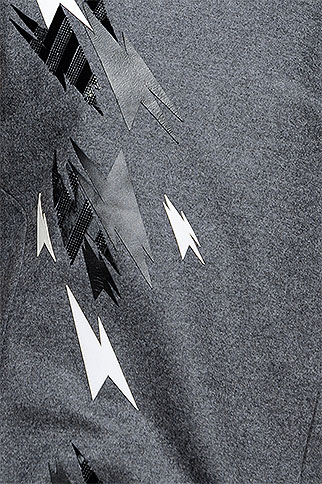, | Comments:
Gray melange is only simple in appearance and unremarkable. In fact, it turns out to be much more advantageous than the classic and conservative black, especially when it comes to everyday wardrobe.
The first thing that comes to mind when you imagine clothing made of melange fabric is sports or household items. And this is logical: the melange is soft, non-marking, very pleasant to the body, warm and at the same time breathing. Such properties are explained by the fact that the real melange fabric is either cotton (shevikot, leotards, carpet rugs and others), or woolen, that is, 100% natural. A characteristic melange pattern with “sparks” of different shades is obtained by dyeing fibers for yarn in different shades.
Gray melange is a homely cozy material, so for trendy or at least interesting looks, you should choose melange things with a catchy and even extravagant decor. The simplicity of melange fabric in combination, for example, with spikes, prints or volumetric applications transforms even plain bows.
|
|
|
Of course, melange is not a place in a business or formal setting, it does not look too successful in vintage images or in the context of boho-chic. In all other cases, the texture and color of gray melange are universal: they can become the basis of a romantic or everyday ensemble, a sport casual or normcore dress.
If you follow the fashion and the market of hand knitting, then you already know that the main trend of this year - degrade - is the effect of color erosion or a gradual flow from one color to another. In recent years, this has been achieved mainly with the help of section-dyed or painstaking selection of shades of monophonic yarn, but a couple of years ago knitwear again appeared on the podium, where the transitions were created by mixing yarn of different colors in different proportions. Designers from around the world remembered and picked up the forgotten technique of melange, so the trend will continue for a couple of years, and we have an occasion to master a new technique for working with color - creating the effect of degraded melange.
Let's mix colors!
For starters, it’s worth understanding the terms.
In relation to knitting, the term degrade is used for the effect of a smooth transition from one color to another. And melange is a word familiar to any knitter. Each of us held in our hands a skein of yarn, which consisted of multi-colored threads or a mixture of fibers, and the ruffled "grandmother's" sweaters and socks that were in every Soviet family, this is also melange - a mixture of different yarns.
The main technique for creating a color transition during melange is the gradual replacement of one or more working threads.
Today I will mix bobbin yarn with a meter of 1599m / 100g in 5 threads. On knitting needles 2, 25 of this yarn in 5 additions, a dense, plastic cloth is obtained.
The yardage of yarn, the number of threads and colors is arbitrary. Those who know the basics of combinatorics can have fun calculating the number of possible combinations of n colors in m additions)
So, the main and most obvious options.
2 colors

Each step is a change of one working thread. Let me remind you that on the sample I made equal sections in 10 rows.
By changing the ratio of sections, you can achieve different effects of thickening and color blur.
I used this technique in the mitts:

Taking a step in 2 threads or excluding several sections, you can achieve sharper borders or create a canvas of "multi-colored" stripes, having only 2 colors in work.
And you can make one or two transitional sections to soften the borders of uniform colors:

Rainbow Stripes by Rabens Saloner
Despite the fact that the number of colors in this model is more than 2, it is precisely the two-color transition that is implemented at the borders of the bands.
An ideal example from the mass market is a pullover with the effect of degrade and arana:

The male version is from DSQUARED. An entertaining optical effect - you can observe how the black color creeping on top “eats” the relief pattern.

No Excess:
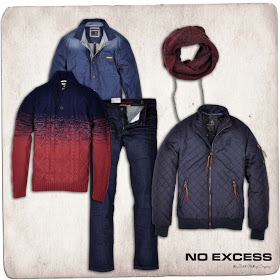
A great way to revive the classics!
3 colors, hverno white
The most popular option, often read by the eye as two-tone. Actually, there are no rules and barriers to the embodiment of a black and white gradient of two colors - it will obey the general logic. The main pitfalls of this option is the ability to work with contrasting colors, since with a stepwise transition, you need to calculate sections of the correct intensity.
I connected the pattern of the transition from white to dark graphite, with an admixture of gray - the most common option, not only in hand, but also in industrial knitwear.
Adding an intermediate gray step softens the contrast and makes the color transition smoother. In addition, in comparison with the canvas with one-colored stripes, the mottled one looks softer, its shape is more blurry.
Only the brave obey the sea!
"Song of the Captain"
Theoretical base
Often, melange floss is understood to mean DMC products, that is, one shade smoothly changes in a skein of floss, but this is not entirely true.
Conventionally, melange can be divided into four groups: variegated, space dyed, shadow dyed and overdyeds. We will see what is the peculiarity of their color schemes and production technologies.
Mouline thread variegated is commercially available from major brands such as DMC and JP Coats. In skein, all threads are colored the same, after 1 meter the color repeats. The DMC cotton melange palette contains 18 colors, the color in a skein of one shade (for example, the transition from pale blue to dark blue). Anchor cotton blend is more diverse in its color scheme, there is even a multi-color (multicolor floss).
Melange space dyed, shadow dyed and overdyeds is practically not represented in Russia, so we are not familiar with it. In fact, these are single-color threads repainted in different colors, and both a large factory and small private production using hand-dyed can produce them.
Space dyed - staining of natural or bleached material with segments, most often the threads are made multicolor. The process can be carried out by machine or manually: liquid paint is sprayed or applied by brush.
Shadow dyed - giving a shade of a natural, bleached or previously dyed thread. As a rule, only one color is used; only its intensity varies along the length of the thread.
Overdyed - manual application of liquid paint at unequal intervals on an already colored thread so that the base color of the thread does not disappear, but harmoniously blends with the new one.
For manual staining, craftsmen use dishes made of inert materials (glass, stainless steel). Several colors can be mixed at once to obtain the desired shade; special reagents are used to accelerate the “setting” process. The necessary mixtures are applied to the thread, and then the master smears the paint with his hand so that the shades begin to smoothly pass into each other. After that, the hanks are loaded into special furnaces to complete the staining process. Then the threads are washed from paint residues, with the help of cold water, the color is finally fixed and suspended in a room without sun with room temperature for drying, which in turn can take 7-10 days. Of course, the craftsmen try to ensure that the colors are stable and do not fade, but no one can guarantee this, so the standard requirement for this kind of melange is the absence of washing (or washing in cold water). Do not forget about various factors (chemical composition of water, moisture level, paint composition), which interfere with the constancy of color in different batches.
One of the most famous manufacturers of multi-colored threads is the Caron Collection (http://www.caron-net.com/). This company produces several grades of hand-dyed threads, for example, Watercolors (100% cotton), Impressions (50% silk, 50% wool), Waterlilies (100% silk). In addition to the thread catalogs, on the company’s website you can find interesting lessons and instructions for working with this category of melange half-cross, and then use the same half-crosses to return to the starting point. Each of these methods gives its own unique effect, you can even try to combine them to get very unique combinations of shades.
With the help of melange you can not only achieve interesting color effects, but also reduce the number of colors in the embroidery.
There is a great temptation to cut the threads, throw out seemingly inappropriate fragments of color transitions, but do not rush to do this, try to follow the color!In rare cases (for example, in the picture “Snowmen”), designers suggest cutting the length of the thread into dark and light colors. To increase contrast, light areas are used near the figures of snowmen, and dark areas along the edges of the image. To soften color transitions, they are embroidered not with even columns, but with a snake. Very interesting effect, isn't it? Embroider the pieces into which the design is divided using the backstitch, embroider as a single unit, moving to a new element only after completely finishing the previous one. So you get a beautiful mosaic effect.
Another option for laying stitches is to create diagonal color transitions. In this way, you can not only embroider the background, but also make a substrate out of it for some kind of complex pattern. A very extreme option is the simultaneous combination of imitation mosaics and the diagonal direction of the color gradient.
And who said that it’s impossible to fold an ordinary thread floss with melange ?! Feel free to experiment! For example, with this combination, autumn leaves will turn out to be more naturalistic. Use one color as a base and 3-4 melange for different areas of leaves.
MELANGE THREADS

Translated from French, melange means "mixture." Based on the name, it becomes clear that the melange yarn is formed by mixing several fibers of different colors, qualities or textures. Usually these are two or more colored fibers colored along the entire length: yellow, red, violet, etc. ... Simply put, the fibers before spinning already have different colors. All of them are tightly intertwined, spun into a single whole, so that the output is a single, cheerful, colorful thread.
Melange is easy to do on your own. In knitting, to obtain such an effect, it is enough to take balls of different colors, wind them into one and knit with the resulting mixture. In embroidery, this technique can be compared with the use of blends, when to obtain a non-standard color, threads of different shades are combined.
In texture, melange can be the most diverse. Manufacturers boldly mix cotton and wool, “grass” and wool, acrylic and mohair, merino and acrylic, etc. Experienced knitters can add a worse quality thread, uneven or unevenly colored to the work. The variegation of the finished product will still hide the imperfections of knitting.
Items made from melange yarn are very elegant and warm. Almost everything is knitted from it, from coats and stoles to handbags, scarves, gloves. There are only two difficulties that can be encountered when working with this unusual thread: against the background of bright variegation, complex patterns can be lost, and it will be difficult to choose matching clothes and accessories.
SECTION DYE THREAD


As the name implies, this is a thread dyed in different colors or tones in pieces, sections. Unlike melange, unpainted thread is spun here, and after that it is painted in large or short sections. For each thread, manufacturers try to choose one or two related colors, but use their different shades from light to dark and vice versa. For example, green - turquoise - blue - blue - light purple - green. Color rapport is always repeated at regular intervals.
If the thread is dyed in short sections (small section dyeing), then the fabric is obtained with a contrasting pattern that resembles a geometric one. Conversely, the longer the colored area, the more smooth and predictable the transition of tones is obtained in the finished product. The length and color of the sections can be adjusted by cutting off unnecessary shades.
To knitting "sectional" you need to adapt and follow a few simple rules. Symmetrical details begin to knit from the same color sections of yarn. If the product is composed of several parts, it is recommended to observe the same arrangement of color bars on them. When embroidery floss sectional dyeing, there are several techniques that allow you to get contrasting or smooth transitions of colors.
This method of dyeing is very common, in the line of almost every manufacturer of floss and yarn there is an excellent selection of "sections" of different shades. The threads are universal, they make cardigans, sweaters, scarves, socks, dresses, swimwear and much more with an interesting color pattern.
MULTICOLOR


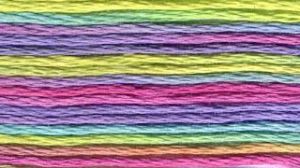
Multicolor threads (from the English multicolor - “multicolor”) are close relatives of section dyeing threads. They are also obtained by dyeing an already spun colorless thread. But if, when painting, the sections try to adhere to the same color and “play” with tones, then in multicolor fantasies give a chance to take a full walk. There may be the most incredible transitions: from yellow to blue, from red to green, from orange to purple.
They work with multicolor as well as with section dyeing yarn.
The article used photo materials from the Lori Photobank: © Elena Rostunova,Joanna Malesa, Tatyana Melikhova
The term "melange" is applied to the connection of different-colored and often multifactured threads. Often this combination allows you to get a very interesting effect. So, melange (see photo below) is selected when several gray threads of different shades are connected.
The canvas connected from them according to the drawing will resemble gray marble. A mixture of blue and green looks like natural malachite.
Interior Application
Melange base is often used for a sofa bedspread. The interlacing of threads of different shades serves as an ideal background for appliqué or large ornament. In this regard, the mottled basis is also used when sewing a dense curtain, bando or lambrequin.
A combination of shades pleasant to the eye can be obtained by mixing threads that are close in tone. For example, it will be magnificent with beige, and mustard with golden. Such a canvas is perfect for curtains when decorating a living room or kitchen. If you connect several multi-colored threads together, you get melange, the color of which will resemble spilled confetti. In combination with monophonic wallpaper, curtains from such a canvas will suit perfectly.
Melange value
The variegation of interconnected threads can be characterized by one old word - "motley". The value of such a canvas is not in its brightness. The combination of different shades allows you to repeat the natural originality. Picturesque woven or knitted ripples of melange canvas can be used when decorating an interior that belongs to any of the modern styles.
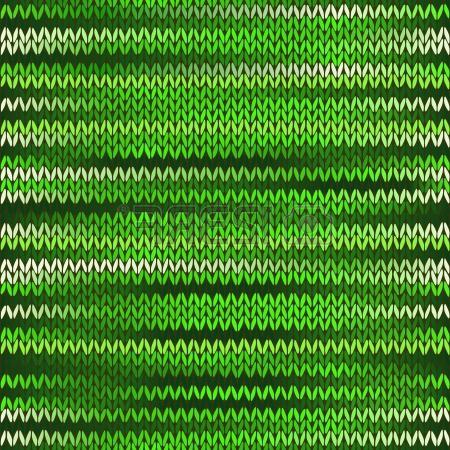
If a variegated woolly thread with a boucle was used in the manufacture of variegated material, then outwardly the textile will turn out to be rough. It will be appropriate for furniture upholstery and sewing curtains for winter sets. Bedspreads will also come out of it, which will especially organically fit into the interior of the ethnic style.
Tapestry making
Reliability of natural shades on the canvas is achieved by skillful selection of combinations of various tones. Such a tapestry may resemble a scattering of broken shells or small
In the event that for melange the threads of a smooth texture are taken, the fabric will turn out flowing and plastic. Granite or lilac fabric can get a slight scuff effect. To do this, it is enough to use a silver thread in its manufacture. Such textiles are relevant for the currently popular style of shabby chic.

Melange, the color of the threads for which is taken blue and green, will give the canvas an imitation of the water surface. The combination of sand, turquoise and ultramarine will give an intense bright ripple that will resemble the plumage of tropical birds. Such textiles are good to use when decorating the interior of the room, on the walls of which monophonic wallpapers are glued. Applicable canvas for sofa bedspreads. This design is appropriate for children's rooms and living rooms, made in
The use of melange for the manufacture of clothing
Knitting lovers are happy to use a combination of threads of various colors. One of the main reasons is the ability to create products that are diverse in color. In addition, on such a canvas, possible irregularities and color defects of the threads are not so noticeable. Thus, in order to knit the desired product, you can take unsuccessfully dyed or uneven yarn. A thread can be obtained by dissolving old things. After it should be added to the yarn, matching in tone. Thus, a great melange. The color can be unique.
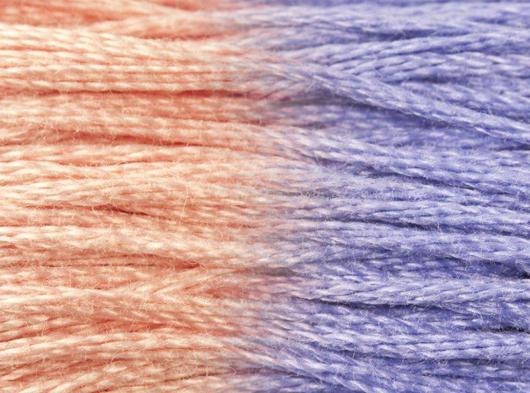
Blended yarn has one very attractive feature: models that are made from it are recommended for full people. Such products visually reduce the volume of the figure, creating the desired color effect.
Drawing up melange
Choosing the right yarn threads for yarn is a responsible matter. In order to prevent a mistake, you should remember the simple rules. First of all, it is important to consider that the color of melange in clothes should have the one that matches your tone as the main thread. Only in this case the mixture will turn out successful.
Suppose you go black. How to make melange? The color for black can be taken green, brown or raspberry. Another combination of threads will be great. Yarn may include a plexus of brown, green and black tones.
Harmonious combinations can tell you the world around you. One has only to look at the wings of butterflies, the coloring of flowers, animals and birds.
Interesting melange. It can happen when weaving a wide variety of threads. With lilac tones, bright red and pink, pale yellow and menthol, denim and violet-purple are perfectly combined.
Brown melange is obtained by weaving brown threads with white and beige. It looks interesting option, where in such a yarn there are white and gray tones.
From melange threads you can knit jackets and coats, skirts and sweaters, hats and scarves, as well as many other things. Multi-colored yarn will be an excellent option for a plaid or covers. Melange summer handbags, a cache-pot for home flowers and many other products are very popular.



